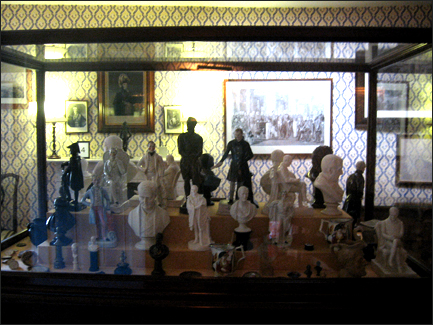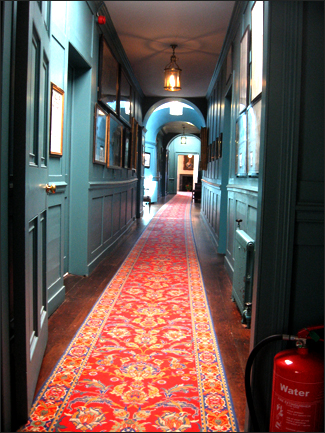
Between 1539 and 1543, King Henry VIII, who feared an invasion after divorcing his Spanish Queen Catherine of Aragon and splitting from the Catholic church, constructed a chain of defensive castles. Built to a common design, the three artillery forts created to protect a stretch of beach along the Kent coast consisted of a central circular keep with lower semi-circular bastions that were arranged symmetrically around the keep to allow several tiers of guns to be mounted. Although one of the three, Sandown Castle, was almost entirely destroyed in the nineteenth century, Deal, the largest of the three, and Walmer survive.
Walmer Castle is often overshadowed by the better known Dover Castle, six miles away, but the Historical Tourist chose to visit Walmer because of its unique history. Although the castle was occupied by Royalists and put under siege by Parliamentarians following the execution of Charles I in 1648, its design had become old-fashioned by the end of the seventeenth century and Walmer Castle began to be used as the official residence of the Lords Warden of the Cinque Ports in 1708. Holders of the post are usually appointed for life, but it is not a hereditary title. The office continues to be “seen as a high honour to be conferred on those who have given especially distinguished service to the State”, so it is not surprising that previous Lords Warden include the Duke of Wellington, Viscount Palmerston, Sir Winston Churchill, and Her Majesty Queen Elizabeth the Queen Mother.

The Historical Tourist has to admit that while she certainly respects this illustrious company, her interest in Walmer Castle is primarily due to another Lord Warden, the Rt Hon. William Pitt, who was born 252 years ago today! The son of the Earl of Chatham, Pitt the Younger became the youngest man ever to become Prime Minister when he took office in 1783 at age 24. Remembered for his gift at managing the nation’s finances and for his eloquence in the House of Commons, Pitt is also one of the longest serving Prime Ministers, in office from 1783-1801, and again from 1804 until his death in 1806.

In a note following his well-written and extremely readable biography of the late Prime Minister, author William Hague wrote that he “felt closest to [Pitt], perhaps, in Walmer Castle, where the panelled landing and the dining room are not dissimilar from how they would have been in his time, and it is possible to imagine him sitting at the head of the table, entertaining military visitors, humouring Lady Stanhope, and going out onto the wide terrace to look for signs of activity at sea” (p 17 *). With such an endorsement, I couldn’t help passing over Deal and even Dover for the official residence of the Warden of the Cinque Ports!

Although the Willingdon room, near the entrance of the castle, contains objects associated with Pitt the Younger, including a mahogany desk and a campaign chair, named because its metal frame meant that it could be taken apart for traveling, Walmer Castle’s most interesting displays are the rooms associated with the Duke of Wellington. Wellington was a frequent visitor who called the castle the “most charming marine residence”. The proximity of Walmer Castle to the port of Dover made it ideal for entertaining foreign royalty, but it was also enjoyed by the British Royal family. Victoria visited the castle at age sixteen and returned seven years later, as Queen, with Albert and two of their children. They stayed for a month.
Today Walmer Castle is home to the Lucas Collection of Wellington Memorabilia, which was donated to the property in 1966. The collection contains portraits and busts, but I was more impressed by the other objects featuring the Duke’s likeness, which included pot lids, paperweights, and even a doorstop!

The smaller Wellington Museum room contains a number of objects associated with the Duke’s Wardenship, including a pair of his famous Wellington boots and the instructions written to the shoemaker about their design. More on the history of Wellington boots can be found in an earlier entry here. The collection also contains a death mask of the Duke, who died at Walmer Castle on September 14th, 1852 at age 83.
Successive Wardens usually bought furniture from their predecessor’s estate, but Lord Palmerston refused to do so and the late Duke’s items were moved to his Apsley House residence so they were not dispersed. After W.H. Smith became Warden in 1891, he initiated the Indenture of Heirlooms by an Act of Parliament so that historic items would remain at Walmer Castle. As a result, when Lady Reading, in the 1930s, attempted to restore Wellington’s bedroom to the way it had been at the time of his death, the original contents of the room were returned to the castle by the fourth Duke of Wellington. Wellington’s bedroom, which is decorated with period appropriate wallpaper, now holds his campaign bed and the armchair in which he died.

My favourite resident is remembered in the Pitt Museum room across the hall. Pitt became the first commoner appointed to the post in 1792. Deeply in debt, he accepted the position because it came with an annual salary of three thousand pounds, and when his finances forced him to give up his country house he moved to Walmer permanently in 1803. The Pitt Museum is smaller than the displays on Wellington, but I enjoyed viewing the Gainsborough-Dupont portrait, political cartoons, and letter written by Pitt that adorn the walls and the leather covered gaming chair and writing desk that likely belonged to him.

During his Wardenship, Pitt created the corridor that runs the full length of the castle, which was painted a vivid teal by the succeeding Granvilles, and added the room later used by the Duke of Wellington as a bedroom to the castle as a winter apartment because it was the warmest part of the castle. He also made important contributions to the castle’s gardens with the help of his niece and hostess Lady Hester Stanhope.

Other rooms at Walmer Castle include the royal bedroom suite used by Queen Victoria and Prince Albert during their month long visit in 1842, the 1920s/30s style drawing room, and the dining room mentioned in William Hague’s biography. The dining room continues to be set with a blue minton service that was used by the Queen Mother, Walmer Castle’s first female Warden, and the grounds contain a garden that was commissioned by English Heritage as a ninety-fifth birthday gift.

* William Hague. William Pitt the Younger. London: Harper Perennial, 2005.










